Today’s Current Affairs: 5th April 2025 for UPSC IAS exams, State PSC exams, SSC CGL, State SSC, RRB, Railways, Banking Exam & IBPS, etc
Table of Contents
Flouride : UP News

The Uttar Pradesh Jal Nigam confirmed the presence of excessive fluoride in 120 hamlets, affecting nearly 2 lakh people. Some villages recorded fluoride levels of 2 mg/L or more, exceeding the safe limit of 1-1.5 mg/L.
- Fluoride is a naturally occurring element found in groundwater.
- The national drinking water limit for fluoride is 1.50 mg/L.
- Excessive fluoride consumption can cause skeletal fluorosis, accelerate dental decay, and pose serious health risks, particularly for children.
- States with High Fluoride Contamination
- Rajasthan has the highest fluoride contamination in India.
- Other affected states include Telangana, western Andhra Pradesh, and eastern Karnataka.
- Fluoride levels spike during the dry, summer pre-monsoon months, with arid regions in western India showing higher contamination than humid areas.
Waqf (Amendment) Bill, 2024:

The Waqf (Amendment) Bill, 2024 was passed by the Lok Sabha and Rajya Sabha.
- The Bill amends the Waqf Act, 1995, allowing the government to regulate Waqf properties and settle related disputes.
- The bill aims to improve Waqf board efficiency, update Waqf definitions, streamline registration, and boost use of technology in record management.
- Waqf refers to an endowment made by a Muslim for charitable or religious purposes, such as building mosques, schools, hospitals, or other public institutions. It is inalienable i.e., it cannot be sold, gifted, inherited or encumbered.
Key Provisions of the Bill 2024:
- Muslim-created trusts under any law will no longer be considered Waqf, ensuring individuals retain full control over their trusts.
- Only practicing Muslims (for at least five years) can dedicate their property to Waqf.
- Properties already registered with Waqf Boards will remain so unless disputed or identified as government land.
- Women must receive their inheritance before Waqf dedication, with special provisions for widows, divorced women, and orphans.
- Section 40 of the original Waqf Act (1995) has been removed, preventing Waqf Boards from arbitrarily declaring properties as Waqf.
- Section 40 of the Waqf Act (1995) gives the Waqf Board the authority to decide whether a property is a Waqf property or not.
- The Waqf tribunals consist of 3 members i.e., a district judge, a state government officer (joint secretary level), and an expert in Muslim law and jurisprudence.
- Aggrieved parties can appeal directly to the concerned High Court within 90 days of receiving the Waqf tribunal’s order.
- An officer above the rank of Collector will investigate government properties claimed as Waqf to prevent any unwarranted claims.
- Waqf institutions’ mandatory contribution to Waqf Boards reduced from 7% to 5% allowing more funds to be allocated for charitable purposes.
- Waqf institutions earning over Rs 1 lakh must undergo audits by State-appointed auditors.
- A centralized portal will automate Waqf property management, improving efficiency and transparency.
- Mutawallis (caretaker of a waqf) must register property details on the central portal.
- The Waqf Boards will include two non-Muslim members for inclusivity, and among Muslim members, at least two must be women.
- Representation from Shia, Sunni, Bohra, Aghakhani, and OBC Muslim communities is also mandated.
- The Limitation Act, 1963, will now apply to Waqf property claims, reducing prolonged litigation.
- The Limitation Act, sets time limits for filing cases to ensure speedy disposal and prevent delays in legal proceedings.
Chandrayaan-3 ChaSTE:

Chandrayaan-3’s Surface Thermophysical Experiment (ChaSTE) became the first instrument to measure in situ temperatures near the moon’s south pole.
- It successfully penetrated lunar soil and deployed a thermal probe, achieving what two previous missions—ESA’s Philae (2014) and NASA’s InSight HP3 (2018)—could not.
- This experiment provided crucial data on lunar surface temperatures, strengthening evidence of water ice deposits.
- ChaSTE’s thermal probe was integrated into the Vikram lander of Chandrayaan-3, which landed on August 23, 2023.
- The probe is equipped with 10 temperature sensors placed 1 cm apart along its length, near the nose-tip.
- It uses a rotation-based deployment mechanism instead of a hammering device, which played a crucial role in its success.
- The motor rotates, pushing the probe downward until the tip touches the Moon’s surface.
- As the probe continues to penetrate deeper, the increasing resistance from the lunar soil helps determine how far it has descended.
- ChaSTE successfully reached a depth of 10 cm in the Moon’s regolith, where it continuously monitored temperature variations until September 2, 2023.
- The final temperature readings from the deep lunar soil confirmed thermal properties essential for lunar exploration.
Katchatheevu Islands:
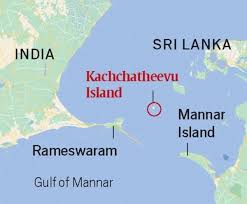
The Tamil Nadu Legislative Assembly has once again unanimously adopted a resolution urging the Union Government to retrieve Katchatheevu from Sri Lanka.
- Katchatheevu is a 285-acre uninhabited island situated in the Palk Strait between India and Sri Lanka.
- It is 33 km northeast of Rameswaram (India) and 62 km southwest of Jaffna (Sri Lanka).
- It Acts as a maritime boundary marker between India and Sri Lanka.
- Fisheries-rich zone, crucial for Tamil Nadu’s fishing economy.
- Anthony’s Church is a place of religious significance for fishermen of both nations.
- It was formed due to a volcanic eruption in the 14th century.
- Initially ruled by the Jaffna kingdom (Sri Lanka), later controlled by the Ramnad Zamindari under the Nayak dynasty (Madurai).
- British India and Sri Lanka both claimed the island until the 1974 agreement settled sovereignty in Sri Lanka’s favor.
- International Maritime Boundary Line (IMBL) between India and Sri Lanka was delineated in 1974 under the Indo-Sri Lankan maritime boundary agreement.
- Established based on UNCLOS (United Nations Convention on the Law of the Sea).
- Maritime boundaries are often defined by the equidistance principle, ensuring a medial line equidistant from both nations’ coasts.
- The IMBL determines Exclusive Economic Zones (EEZs), Territorial waters and other maritime zones.
- The 1974 agreement adjusted the equidistant line, leading to Katchatheevu falling under Sri Lanka’s sovereignty.
Euphaea Wayanadensis:
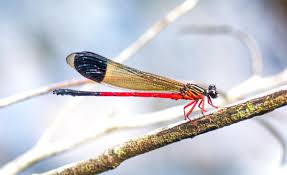
A new species of damselfly, Euphaea wayanadensis, has been discovered in the Wayanad region of the Western Ghats, Kerala.
- It Belongs to the family Euphaeidae.
- Initially observed in 2013 at the Kalindi River, Thirunelli, in Wayanad district, Kerala.
- Further sightings occurred from 2013 to 2019 in Wayanad, followed by more observations from 2019 to 2023 in Aralam (Kannur, Kerala) and the western slopes of Coorg (Karnataka).
- Initially misidentified as Euphaea pseudodispar, a species from Maharashtra.
- Later confirmed as a distinct species through detailed morphological study and genetic analysis.
AFSPA Extension in Northeast States:
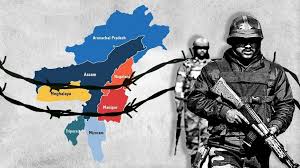
The Central government extended the ‘disturbed area’ status under the Armed Forces (Special Powers) Act (AFSPA), 1958 across Manipur, excluding areas under 13 police stations in five districts, for another six months.
- The Centre also extended AFSPA in parts of Nagaland and Arunachal Pradesh until 30th September 2025.
- AFSPA was passed by Parliament in September 1958 and implemented in response to escalating violence in the northeastern states, which the state governments were unable to control.
- It enables certain special powers to be conferred upon members of the armed forces in “disturbed areas.”
- Both the state and Union governments can issue notifications declaring certain areas as “disturbed”, granting the armed forces the authority under AFSPA.
- In disturbed areas, armed forces personnel are empowered to use force (even lethal), arrest without warrant, and conduct searches without warrant to maintain public order and tackle threats.
- Under AFSPA, armed forces personnel are protected from legal proceedings for actions taken under the Act, unless prior sanction is obtained from the Central Government.
North Sentinel Island:
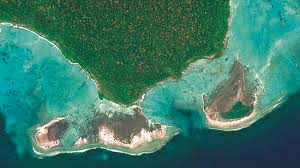
A U.S. national was recently arrested in the Andaman and Nicobar Islands for allegedly entering the prohibited tribal reserve area of North Sentinel Island.
- It is one of the Andaman Islands – an archipelago in the Bay of Bengal – and part of the Indian Union Territory of Andaman and Nicobar Islands.
- It is located west of the central cluster of the Andaman Islands.
- The island measures approximately 8 kilometers (5.0 mi) in length and 7 kilometers (4.3 mi) in width, covering an area of about 60 square kilometers (23 sq mi).
- The island is densely covered in tropical rainforest.
- It’s also circled by a shallow reef.
- It harbours one of the world’s last secluded tribes — the Sentinelese.
- They are believed to be direct descendants of the first humans who migrated out of Africa around 60,000 years ago.
- The tribe has lived in voluntary isolation for thousands of years, fiercely resisting contact with the outside world.
- The island falls under the Andaman and Nicobar Protection of Aboriginal Tribes Act, 1956, making it illegal to approach closer than 5 nautical miles.
- According to a 2011 census effort, and based on anthropologists’ estimates, there are probably somewhere between 80 and 150 people on North Sentinel Island, although it could be as many as 500 or as few as 15.
INS Tarkash:

The Indian Navy’s frigate INS Tarkash, which has been deployed in the Western Indian Ocean for maritime security operations, has intercepted and seized over 2500 kg of narcotics recently.
- It is a state-of-the-art stealth frigate of the Indian Navy. It is part of the navy’s Western Fleet.
- It belongs to the Talwar class of guided missile frigates. These are modified Krivak III-class frigates built by Russia.
- INS Tarkash was built at the Yantar shipyard in Kaliningrad,
- It was commissioned and inducted into the Indian Navy on November 9, 2012, at Kaliningrad, Russia.
- It uses stealth technologies and a special hull design to ensure a reduced radar cross-section.
- It has a length of 124.8 m, a beam of 15.2 m, and a draught of 4.2 m (13 ft 9 in).
- Top Speed: 32 knots (59 km/h; 37 mph).
- It has been equipped with a weapon sensor that enables it to address threats in all dimensions.
- It can board one Ka-28 Helix-A antisubmarine helicopter or one Ka-31 Helix-B airborne early warning helicopter.
- Supersonic BrahMos missile system, advanced surface-to-air-missile system, upgraded 100mm medium range gun, optically controlled 30mm close-in weapon system, torpedoes, rocket launchers, and advanced electronic warfare/communication suite.
Binturong:
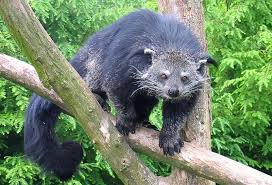
A rare Binturong was recently captured on a camera trap set up by the Wildlife Trust of India’s Garo Green Spine project team in the Narang Wari Village Reserve Forest (VRF), located in the buffer zone of Balpakram National Park.
- It is a catlike omnivore of the civet family.
- It is the largest civet in India, colloquially known as the bearcat.
- Scientific Name: Arctictis binturong
- It is found in dense forests of Southeast Asia.
- Its range extends from Nepal, India, and Bhutan southward to the Indonesian islands of Sumatra and Java and eastward to Borneo.
- The head and body measure about 60–95 cm and the tail an additional 55–90 cm; weight ranges from about 9 to 14 kg (20 to 31 pounds).
- It has long, shaggy hair, tufted ears, and a long, bushy, prehensile tail.
- The colour generally is black with a sprinkling of whitish hairs.
- It is principally nocturnal and crepuscular (that is, active during twilight).
- It is found most often among the trees, using its prehensile tail as an aid in climbing.
- It has scent glands, which are located just under its tail. These glands are used to mark trees and foliage to outline an individual’s territory.
- Conservation Status:
- IUCN: Vulnerable
- Wildlife Protection Act of 1972: Schedule I
- CITES: Appendix III
Compassion And Primary Health Care : WHO Report
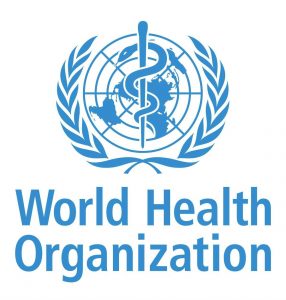
The World Health Organization (WHO) released a report titled “Compassion and primaryhealth care(PHC)” highlights compassion as key to improving PHC and addressing rising mental health challenges through patient-centered, dignified care.
- Compassion in PHC is the recognition of human suffering coupled with the motivation and action to alleviate it within the context of essential health services.
- It is not just a moral value but a practical driver that enhances the quality, accessibility, and equity of care.
- Compassion differs from sympathy and empathy. Sympathy is passive and pity-driven, while empathy can cause emotional fatigue.
- In contrast, compassion combines emotional connection with thoughtful action, making it a more sustainable and effective approach in health care.
- The lifetime prevalence of mental disorders in India is 13.7%, and 15% of India’s adult population experiences mental health issues.
- WHO estimates that the burden of mental health problems in India is 2443 disability-adjusted life years (DALYs) per 10000 population.
- The economic loss due to mental health conditions, between 2012-2030, is estimated at USD 1.03 trillion.
- In India 70% to 92% of people with mental disorders do not receive proper treatment due to lack of awareness, stigma, and shortage of professionals.
- With rising cases of depression and anxiety, compassion has become a vital component in healthcare. It promotes people-centred care by making services more responsive, respectful, and holistic.
- Moreover, compassion strengthens the entire health continuum spanning prevention, health promotion, treatment, rehabilitation, and palliative care, ensuring that care delivery is both effective and empathetic.
- Compassion fosters inclusive care, especially for Dalits, Adivasis, LGBTQ+ individuals, persons with disabilities, and other marginalised groups.
Great Red Spot : New Observation

New observations of the Great Red Spot on Jupiter have revealed that the planet’s atmosphere above and around the infamous storm is surprisingly interesting and active.
- It is an anticyclone, a long-lasting area of high pressure on Jupiter creating a persistent storm.
- Located in Jupiter’s Southern Hemisphere, it appears as a giant red spot on Jupiter’s surface. The source of the red coloration is unknown.
- It extends well above Jupiter’s main cloud layers.
- It is the largest known storm in the Solar System. With a diameter of 15,400 miles, it is almost twice the size of the entire Earth and one-sixth the diameter of Jupiter itself.
- Winds inside this Jovian storm reach speeds of about 270 mph.
- It has existed for the last 150 years, possibly even longer.
- The long lifetime of the Red Spot may be due to the fact that Jupiter is mainly a gaseous planet.
- It possibly has liquid layers but lacks a solid surface, which would dissipate the storm’s energy, much as happens when a hurricane makes landfall on the Earth.
- However, the Red Spot does change its shape, size, and color, sometimes dramatically.
What are Synthetic Drugs?
India is facing a surge in synthetic drug trafficking. In response, Haryana’s Narcotics Control Bureau has set up an Anti-Synthetic Narcotics Task Force to track networks, monitor precursor chemicals, and dismantle hidden labs in the state.Synthetic drugs are often slightly modified to create new psychoactive substances (NPS) that fall outside the Narcotic Drugs and Psychotropic Substances Act (NDPS), 1985 purview. Synthetic drugs are fully created in labs using precursor chemicals (a compound that participates in a chemical reaction that produces another compound) and do not require any plant-based components.
Fram2 Mission and Polar Orbit:
SpaceX has launched the Fram2 mission, which lifted off aboard a SpaceX Crew Dragon capsule from NASA’s Kennedy Space Center in Florida.This private spaceflight is the first human mission to follow a polar orbit (a trajectory never before traveled by humans) and aims to conduct research on spaceflight’s impact on the human body during a free-flying mission.Polar Orbit is a type of low Earth orbit (200–1000 km altitude) where satellites travel around Earth from, roughly, one pole to the other (may deviate up to 10 degrees from exact polar orbit), rather than from west to east. These orbits are ideal for global Earth observation as they provide complete surface coverage
Tiger TRIUMPH 2025:
On 1st April 2025, the Indian Navy inaugurated the 4th edition of the bilateral joint Humanitarian Assistance and Disaster Relief (HADR) amphibious exercise, Tiger TRIUMPH 2025.The exercise, to be conducted in two phases, aims to strengthen U.S.-India strategic maritime cooperation and reinforce their defense partnership. Harbour Phase: Held in Visakhapatnam, this phase focuses on planning sea-based training exercises and includes sessions on special operations, and multi-domain operations across air, maritime, cyber, and space. Sea Phase: Bilateral forces will conduct maritime, amphibious, and HADR operations through a Joint Combined Command and Control Center.
Underwater Cables:
Airtel’s 2Africa Pearls subsea cable has landed in India, boosting internet capacity by 100 Tbps, highlighting the growing need for robust undersea cable infrastructure.Undersea or submarine cables are fibre-optic cables laid on the ocean floor that enable global internet and telecommunication connectivity. Cables carry data using light signals transmitted through hair-thin glass fibres, encoded by lasers at high speeds.As of early 2025, there are over 600 active and planned cables globally, spanning 1.48 million kilometres.
Digital Child Abuse Due to AI:
The International AI Safety Report 2025 and the U.K.’s draft law criminalising AI tools generating CSAM (Child Sexual Abuse Material) have sparked global discussions.It refers to the creation, possession, and dissemination of child sexual abuse material (CSAM) using AI tools like generative AI, deepfakes, and image synthesis technologies. These depictions may or may not involve real children.
Baku to Belem Roadmap:
India, at the 11th BRICS Environment Ministers’ Meeting in Brazil, urged all 11 BRICS nations to support the ‘Baku to Belem Roadmap’, which aims to mobilise $1.3 trillion annually by 2035 for climate action.The ‘Baku to Belem Roadmap’ is a finance mobilisation framework initiated between COP29 (Baku, Azerbaijan) and COP30 (Belem, Brazil). It aims to chart a path for mobilising $1.3 trillion per year by 2035 for climate action in developing countries. UNFCCC COP Presidencies (Azerbaijan and Brazil) are mandated to lead the process.
YuvaSpark Founder Akarsh Shroff Conferred with National Youth Award for Transforming Early Education in India:
Akarsh Shroff, the founder of YuvaSpark, was conferred the National Youth Award on April 3, 2025, for his pioneering efforts in enhancing early childhood education in India, particularly through anganwadi digitisation and innovation in rural education infrastructure..The National Youth Award, instituted by the Ministry of Youth Affairs and Sports, is conferred annually to individuals under 30 years of age who have shown exemplary commitment to national development and social service. The award was presented to Akarsh by Union Minister Mansukh Mandaviya at a ceremony held at the Parliament House, New Delhi. The event recognised awardees from both the current and previous year, with a total of 22 young changemakers honoured.
Women’s Prize for Non-Fiction 2025:
The Women’s Prize for Non-Fiction 2025 has announced its shortlist of six exceptional books, celebrating voices that span across themes of nature, identity, resilience, and memory. In only its second year, this prestigious prize has already made a significant impact in showcasing powerful stories by women authors from around the globe.
Non-Fiction 2025 Shortlist:
- Ocean’s Silent History: What the Wild Sea Can Be by Helen Scales
- Bond Beyond Species: Raising Hare by Chloe Dalton
- A Life in Harmony and Disruption: A Thousand Threads by Neneh Cherry
- Generosity Beyond Life: The Story of A Heart by Rachel Clarke
- Women in Transition: Private Revolutions by Yuan Yang
- Remembering a Resistance Heroine: Agent Zo by Clare Mulley
Cabinet Approves Patna-Arrah-Sasaram Corridor & Kosi-Mechi Intra-State Link Project:
To boost connectivity and agricultural irrigation in Bihar, the Cabinet Committee on Economic Affairs (CCEA) chaired by Prime Minister Narendra Modi has approved two key infrastructure projects—the Patna-Arrah-Sasaram Corridor and the Kosi-Mechi Intra-State Link Project. These projects aim to support regional development, generate employment, and align with the government’s vision of “Atmanirbhar Bharat.”
Nikhil Singhal Honored with Uttar Pradesh Anmol Ratan Award:
Nikhil Singhal, a distinguished media strategist, Founder of Vigor Media Worldwide, and President of the Noida High Rise Federation, has been honored with the prestigious Uttar Pradesh Anmol Ratan Award. The award ceremony was organized by the Tapasya Foundation Trust at the Taj Lucknow on March 31, 2025. This recognition highlights his remarkable contributions to the public relations industry and his exemplary leadership in strategic communication.
Maharashtra Governor C P Radhakrishnan Inaugurates 62nd National Maritime Day and Merchant Navy Week:
The 62nd National Maritime Day and Merchant Navy Week were officially inaugurated by Maharashtra Governor C P Radhakrishnan at Raj Bhavan, Mumbai. The event, held on April 5, 2024, aimed to highlight the significance of India’s maritime sector in achieving the vision of Viksit Bharat (Developed India).
Kamal Haasan Appointed Chairperson of FICCI Media and Entertainment Committee South:
Renowned actor and filmmaker Kamal Haasan has been appointed as the Chairperson of the Federation of Indian Chambers of Commerce and Industry’s (FICCI) Media and Entertainment Committee South. The announcement was made during the FICCI’s Media and Entertainment Business Conclave South Connect 2025, held in Chennai. The appointment highlights his influence in the media and entertainment industry, as well as his vision for the sector’s future growth.
Niharika Singhania’s Gold in the Azelhof CSI Lier Equestrian Competition:
Niharika Singhania, a young Indian equestrian athlete, made the nation proud by securing the first position in the renowned Azelhof CSI Lier equestrian competition held in Belgium. Competing against international participants, she exhibited remarkable skill, composure, and determination. Niharika’s victory in the competition highlights the importance of balancing academics with extracurricular activities and emphasizes the power of hard work, dedication, and rigorous training in achieving success.
Aditya Birla Capital Merged With Aditya Birla Finance Ltd.:
Aditya Birla Capital Limited (ABCL) has successfully completed the amalgamation of its wholly owned NBFC subsidiary, Aditya Birla Finance Ltd. (ABFL), with itself. The merger, effective from April 1, 2025, follows approvals from shareholders, creditors, and regulatory bodies, including SEBI, RBI, and NCLT. This move aims to simplify the corporate structure, enhance financial stability, and increase operational efficiency. The leadership transition sees Ms. Vishakha Mulye appointed as MD & CEO and Mr. Rakesh Singh as Executive Director & CEO (NBFC), subject to approvals.
Francesco Bagnaia Triumphs at Grand Prix of the Americas After Marc Marquez Crash:
The Grand Prix of the Americas witnessed an intense race on Sunday as Francesco Bagnaia claimed victory after Marc Marquez, who was on a winning streak, crashed out on lap nine. The event, held at the Circuit of the Americas (COTA), saw Ducati dominate the podium, with Alex Marquez securing second place and Fabio Di Giannantonio finishing third. This victory marked Ducati’s 20th consecutive grand prix win, bringing them closer to Honda’s record of 22.




